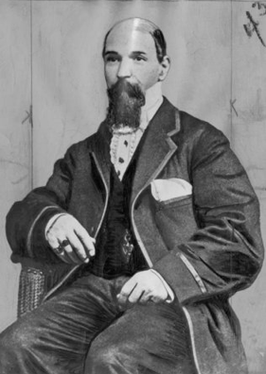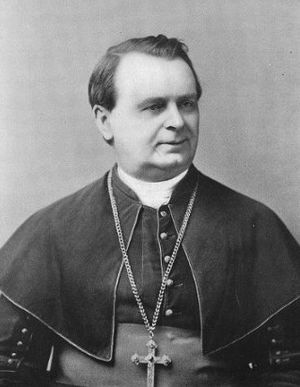John McKee (philanthropist) facts for kids
Quick facts for kids
John McKee
|
|
|---|---|
 |
|
| Born | 1821 |
| Died | 6 April 1902 |
| Nationality | American |
| Occupation | Property owner |
| Known for | Disputed legacy |
Colonel John McKee (born 1821 – died 1902) was a very rich African American man. He owned a lot of property in Philadelphia. A town called McKee City, New Jersey is even named after him! Today, his money still helps fund scholarships for boys who don't have parents.
Contents
John McKee's Early Life
John McKee was born in Alexandria, Virginia around 1821. When he was about 19, records described him as a "bright mulatto boy" who was born free. This meant he was not a slave.
As a teenager, he worked for a bricklayer. He tried to run away but was brought back to finish his training. Later, he moved to Philadelphia and first worked at a stable where horses were kept.
McKee then became a waiter for James Prosser, who owned a popular restaurant. John McKee married Emeline, Prosser's daughter. He took over running the restaurant until 1866.
It is believed that McKee fought in the American Civil War (1861–1865). In 1870, he joined the Pennsylvania National Guard. By 1872, he became a lieutenant colonel in the 13th Regiment.
Becoming a Property Tycoon
After the Civil War, many formerly enslaved people moved north to find new chances. In Philadelphia, McKee saw an opportunity. He offered them affordable homes. In return, he often received rent or even ownership of land they had been given in the South.
McKee grew his property empire. He owned houses in Philadelphia. He also bought large areas of land in West Virginia, Georgia, and Kentucky. He later sold some of his southern land. With that money, he bought even more land in Philadelphia, New York, and New Jersey.
People who knew McKee said he was very careful with his money. He didn't spend much on his office or on fixing his houses. One newspaper said he was "a man absolutely devoid of sentiment," meaning he didn't show much emotion.
Eventually, McKee owned between 300 and 400 houses in Philadelphia. He also owned about 300,000 acres of land with coal and oil in Kentucky and Logan County, West Virginia. He had land near Philadelphia and along the Delaware River.
McKee City: A Planned Community
"McKee City" in New Jersey was a special project. It was a 4,000-acre area that McKee planned as a community. It was meant for African Americans who moved north after the Civil War. It had a school, a church, and simple dormitory-style houses.
The houses in McKee City were well-built but basic. They didn't have fancy things like indoor plumbing or heating. The rental agreements were made so that tenants would improve the land. Colonel McKee had big plans for this community, but he died before they could all come true.
John McKee's Family and Wealth
John McKee had two daughters. His daughter Jennie married a lawyer and had one son, Henry McKee Minton, who later became a famous doctor. Sadly, Jennie died before her father. His other daughter, Abbie, married Douglas Syphax. Douglas and Abbie had five children.
McKee's wife passed away in the 1880s. Colonel John McKee died at his home in Philadelphia on April 6, 1902. He was buried at Olivet Cemetery. His daughter Abbie and six grandsons survived him.
When he died, he was thought to be the richest African American person. Newspapers guessed his fortune was between $1.5 million and $4 million. This was a huge amount of money back then!
McKee's Lasting Legacy
When Colonel McKee died, his will was a surprise. He left his daughter Abbie a small house and only $300. Each of her children and Henry McKee Minton received $50. Most of his huge fortune, about $2 million, went to the Catholic Church.
He wanted the money to be used for two main things. First, to build a Catholic church, rectory, and convent in McKee City, New Jersey. Second, to build and support a charity in Philadelphia. This charity would educate orphaned boys, both white and black.
McKee chose the Catholic Church because Catholic nuns helped him when he had typhoid fever in 1896. Other caregivers had turned him away, but the nuns helped him and other African Americans.
The Planned College and Scholarships
McKee planned for a "Colonel John McKee's College." This college would be built only after all his children and grandchildren had passed away. The college would offer naval training to poor orphaned boys from Philadelphia, both black and white. He also wanted a bronze statue of himself on horseback in front of the college.
McKee's will caused some disagreements. His daughter Abbie and grandson Henry McKee Minton eventually received more money after legal challenges. Abbie received $110,000, which was a very large sum at the time.
One of Abbie's sons, Theophilus John Minton Syphax, later changed his name to T. John McKee. He tried to claim a part of his grandfather's estate that had not been given out yet. He was able to prove he was McKee's heir, but he died before getting the money.
McKee's great-grandchildren also challenged the will. In 1952, a judge decided that the remaining money, over $1 million, should be used for scholarships. These scholarships would help orphaned black and white boys get an education.
The college was never built, and the statue was never made. However, by 2012, over 1,000 orphaned boys had received McKee Scholarships. In 2012, the scholarship committee got permission to use some funds to place a tombstone for McKee and his wife. It has an image of a man on horseback, honoring his original wish.
Images for kids




